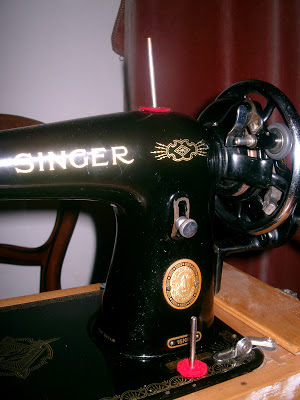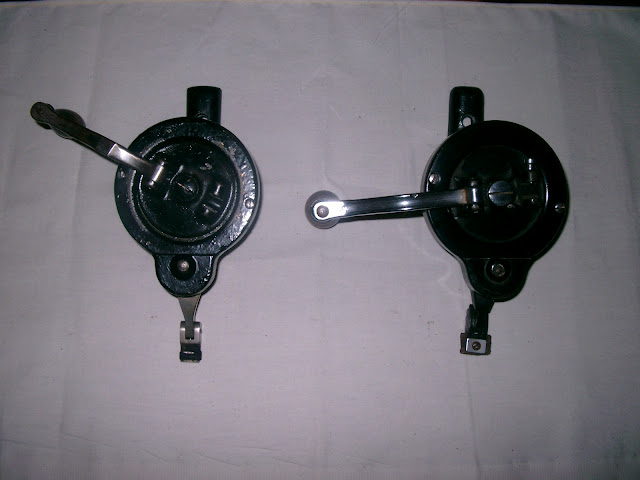
 Remember the crooked makeshift spool pin the 15K80 had when it arrived? If not see the photograph on the left for a reminder. The picture on the right was taken after I fitted the proper Singer part. Fitting turned out to be very easy. The most important thing was making sure I got the correct hole. I didn't want to end up blocking up an oiling point with the pin! I couldn't find the rubber-faced mallet so I gently tapped the new pin home with a steel claw hammer. Probably not to be recommended but I was very careful. As well as being the right size and shape the spool pin is firmly fixed. It's a small thing but I think it really improves the aesthetics of the machine. The difference in reality is probably more marked than in my pictures.
Remember the crooked makeshift spool pin the 15K80 had when it arrived? If not see the photograph on the left for a reminder. The picture on the right was taken after I fitted the proper Singer part. Fitting turned out to be very easy. The most important thing was making sure I got the correct hole. I didn't want to end up blocking up an oiling point with the pin! I couldn't find the rubber-faced mallet so I gently tapped the new pin home with a steel claw hammer. Probably not to be recommended but I was very careful. As well as being the right size and shape the spool pin is firmly fixed. It's a small thing but I think it really improves the aesthetics of the machine. The difference in reality is probably more marked than in my pictures.Although I am not the number one fan of the blond wood base this machine currently resides in I am pleased with the way it has cleaned up. I used fine grade steel wool and Black Bison wax. This removed dirt, white marks (which might have been plaster of paris or poster paint. I have been told that this machine spent some of its life in a primary school) and even imparted a slight shine. It has improved the appearance (and smell) of the base so much I am tempted to try the technique on the case that my 28K came in. The 'coffin lid' is so dirty and dull I doubt that anything I do to it could make it look worse.
- the lug/finger thingy seams too narrow for the space between the spokes of the hand wheel
- the lug/finger thingy is so long it fouls the bobbin winder when engaged.
This pic shows the hand crank taken from my 15K80 on the left and another Singer crank I managed to get hold of on the right. It came from a 1936 Singer 99K someone was "breaking for spares". Spot the difference. The one on the right has a shorter wider lug. The one on the left is exactly the same as the crank on my 28K.
 |
Not all Singer cranks are the same |
In the next picture take a good look at the brackets which hold the cranks to the body of the machine. The 28K type [on the left] is shorter than the later type [on the right] . The combination of shorter lug and longer bracket on the newer hand crank explains why the crank that came with this machine was fouling the bobbin winder.
All back together again and happily winding a bobbin with new navy blue Guterman's.
The new crank
- is plain black so it doesn't clash with the decoration elsewhere on the machine
- is a much better fit in the spokes of the balance wheel which results in quieter running
- doesn't foul the bobbin winder when it is engaged




























